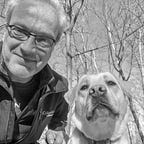The meaning of bricks
So, today, I’ll show you one of my favorite photos. In fact, I love it so much that I had it printed poster size and framed, it has been the center point of my living room for 10 years.
The backstory is simple, Christmas 2010, my wife and I visited my mother in rural Germany, it had been snowing, nothing major but enough to dust the ground. Snow creates design by removing colors and turning everything it touches into an abstract. I had my Nikon D300 and was trying to capture that transition.
When we arrived at my mum’s farm, I noticed the unique architecture of my childhood, the shape of houses, the angle of rooflines against the grey sky and the old barns that had been rebuilt dozens of times. Architecture and environment merging into a reality that defines the place and time.
Farms have kitchen gardens, kitchen gardens have straight paths created from bricks and stones that were leftover when the house was built. Uneven, unloved , broken bricks interspersed with a random flat rock, placed on stamped sand or grit they are the epitome of utilitarian design. But where the paths meet in the middle, bricklayers create a whimsy circle, an object of art, not because they are forced to do it but because this is how they have always done it.
The day we visited, the brickwork was covered with a fine dust of snow, some stones warmed themselves in the low sun while the gaps between them remained filled with a few millimeters of powder.
For some reason, I immediately knew that I had one of my favorite photos in front of me. At that time, there was no doubt but a sense of purpose, a sudden clarity and the shutter was pressed, the design had jumped from the ground into the camera.
The resulting photo was not a perfect “shot” in the photographic sense, it doesn’t deserve awards, upvotes or critical review. It is just a perfect representation of the very moment as I experienced it. My mother’s farmhouse, the style and architecture, the ephemeral snow covering and then melting and the transition of reality into graphic design and then memory.
This photo is a self portrait.
